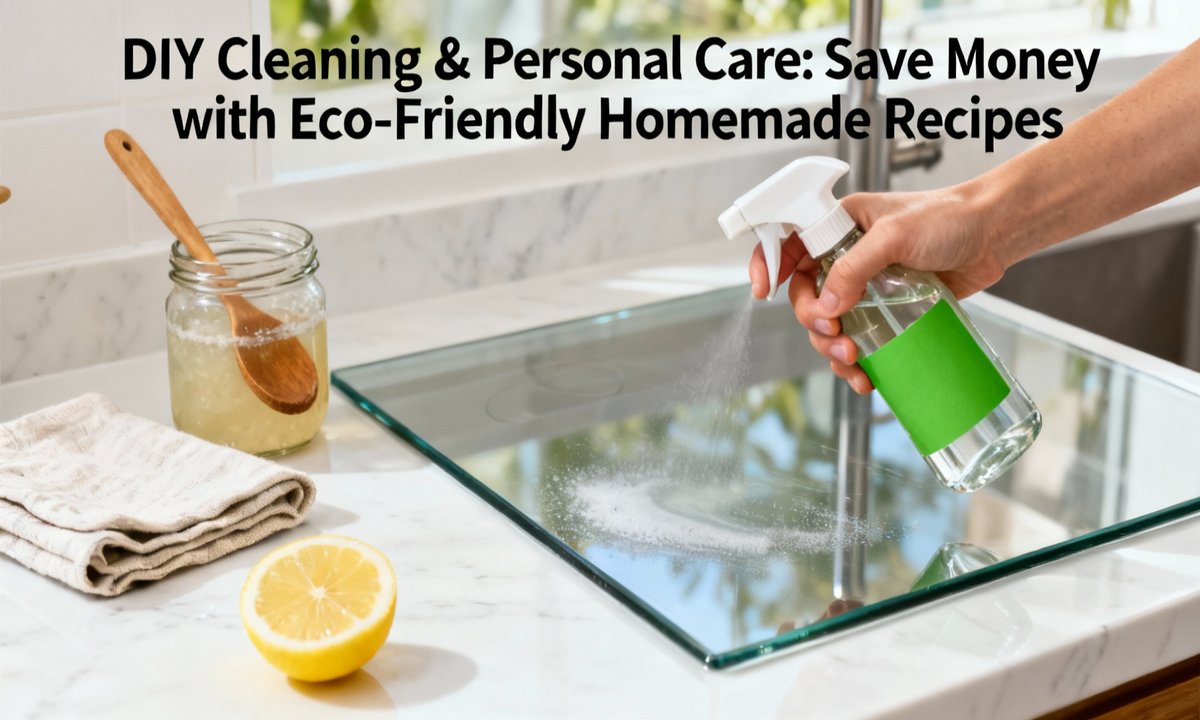In today’s world, embracing eco-friendly homemade cleaners and personal care items offers a smart path to saving money. It also helps to reduce your exposure to harsh chemicals. With basic kitchen ingredients and simple knowledge, you can replace expensive store-bought products. Discover effective, natural cleaning solutions and sustainable personal care essentials.
Expect easy, beginner-friendly DIY cleaning recipes using items you likely already have at home. Before diving in, consider how saving on everyday essentials contributes to larger financial goals. For more strategies to boost your budget, explore Master Your Money: 10 Frugal Living Hacks to Save Thousands This Year.
If you seek a comprehensive toolkit for a healthier home, consider The Ultimate Eco-Friendly Cleaning Kit: Must-Have Products for a Non-Toxic Home. This guide helps you create a cleaner, safer environment. Making your own products empowers you with choices for a better home.
The Benefits of DIY: Eco-Friendly Cleaning & Personal Care
There’s a growing interest in natural cleaning products and non-toxic household alternatives. People are prioritizing both their health and overall sustainability. Homemade recipes give you full control over ingredients, eliminating hidden irritants or unknown fragrances.
This approach also significantly reduces plastic waste and chemical runoff, lowering your home’s environmental footprint. Many DIY homemade disinfectants and plant-based cleaner alternatives often deliver results that match, or even surpass, commercial options (source).
Another advantage is the ability to create custom scents and formulas. Tailor your recipes to exactly what your space needs, rather than relying on mass-produced options. For more insights on building a truly sustainable living space, review Sustainable Home: Eco-Friendly Products for a Greener Living Space.
This DIY philosophy extends effortlessly to personal care as well. Why depend on store-bought lotions, toothpastes, and deodorants filled with complex chemicals? Instead, you can easily craft simple, sustainable personal care recipes for your entire family.
Explore non-toxic alternatives for various needs, from personal hygiene to laundry. You can confidently know every ingredient used in your homemade items. Are you ready to refresh your home and body, saving both money and the environment? Let’s get started.
Essential Ingredients & Safety Guidance for Homemade Products
You don’t need to search for rare ingredients to begin making eco-friendly homemade cleaners. Most natural cleaning products and personal care solutions rely on common household components. These staples are often readily available.
Here are the key ingredients you’ll frequently find in these recipes:
– Baking soda: An effective gentle abrasive and reliable deodorizer, useful from stovetops to deodorant (source).
– Distilled white vinegar: Known for dissolving mineral buildup, cutting through grease, and offering germ-fighting properties (source).
– Castile soap: A plant-based and biodegradable option, ideal for a non-toxic household cleaner.
– Hydrogen peroxide: An eco-friendly disinfectant that safely breaks down into water and oxygen.
– Lemon juice: Naturally degreases surfaces and imparts a fresh, clean scent (source).
– Essential oils: Used to add natural fragrance, with some varieties like tea tree, lavender, or lemon offering enhanced cleaning power (source).
– Reusable cleaning cloths: A sustainable alternative to disposable paper towels, reducing waste (source).
Important Safety Tips for DIY Cleaning
When making and using homemade products, safety is paramount. Always label your homemade creations clearly and store them safely out of reach of children and pets. This prevents accidental ingestion or misuse.
Never combine products containing bleach with ammonia, as this can create dangerous fumes. Also, be cautious with vinegar-based cleaners on natural stone surfaces like marble or granite, as they can cause etching. For deals on these ingredients, learn some Smart Grocery Shopping: Unlocking Supermarket Secrets to Cut Food Costs.
DIY Eco-Friendly Cleaning Product Recipes
Prepare to make your home sparkle with less effort and fewer worries about harsh chemicals. These tried-and-true, eco-friendly homemade cleaner recipes are safe for the whole family. Each recipe includes clear instructions and important cautions to ensure maximum effectiveness and safety during use.
Homemade All-Purpose Cleaner
This versatile cleaner is perfect for various hard surfaces around your home. It combines effective natural ingredients for a fresh and clean result.
Ingredients:
– 1/2 cup white vinegar
– 2 tablespoons baking soda
– 10 drops essential oil (tea tree, lavender, or lemon are great choices)
– Water to fill a 12oz spray bottle
Instructions:
1. Mix the vinegar, essential oil, and a portion of the water in your spray bottle.
2. Slowly add the baking soda; expect it to fizz. This reaction helps mix the ingredients.
3. Fill the remainder of the bottle with water, then gently shake to combine.
4. Spray on hard surfaces, wipe clean, and allow to dry for a streak-free finish.
Caution: Avoid using this cleaner on natural stone countertops, as vinegar can damage them (more info).
Creamy Soft-Scrub Cleaner
Ideal for tackling grime on various surfaces, this scrub provides gentle abrasion without harsh chemicals.
Ingredients:
– 2 cups baking soda
– 1/2–2/3 cup liquid castile soap
– 4 tsp vegetable glycerin (optional, adds smoothness)
– 5 drops essential oil (optional, for scent)
Instructions:
1. Mix all ingredients thoroughly until a creamy paste forms. This creates an effective cleaning agent.
2. Store the paste in a sealed glass jar, where it can last for up to two years.
Best for: Kitchen counters, sinks, bathroom surfaces, and stovetops. For particularly tough jobs, pre-spray the surface with vinegar before applying the scrub (detailed recipe).
Homemade Disinfectant Wipes
These reusable wipes are perfect for quick cleanups and help reduce paper waste.
Ingredients:
– 1 cup water
– 1/4 cup vinegar
– 8 drops each of tea tree, eucalyptus, and lemon essential oils
– 15–20 squares of fabric (from old shirts or towels)
Instructions:
1. Place your fabric cloths into a reusable container suitable for storage.
2. Mix the water, vinegar, and essential oils together, then pour this solution over the cloths.
3. Once used, simply launder and reuse the cloths, making them a sustainable choice.
Tip: These wipes are excellent for quick cleanups throughout your home, offering convenience and eco-friendliness (full method).
Natural Liquid Dish Soap
This homemade dish soap is effective for daily washing and gentle on your hands.
Ingredients:
– 1/2 cup warm distilled water
– 2 tsp kosher salt
– 1/2 cup white vinegar
– 1/2 cup plant-based dish soap (or Sal Suds for a strong clean)
– 1 tsp lemon juice
– Lemon essential oil (optional, for extra scent and degreasing)
Instructions:
1. Dissolve the kosher salt completely in the warm distilled water.
2. In a separate bowl, mix the vinegar, plant-based dish soap, and lemon juice.
3. Combine the two mixtures, add essential oil if desired, blend well, and store in a cleaned bottle.
Best for: Daily dishwashing; add extra soap for heavily greasy items (step-by-step).
Green Cleaning Oven Cleaner Alternative
Say goodbye to harsh chemical oven cleaners with this effective, natural paste.
Ingredients:
– 1/2 cup baking soda
– 2–3 Tbsp water
– 1/2 cup white vinegar (for finishing)
Instructions:
1. Create a thick paste by mixing baking soda and water.
2. Apply this paste to the interior surfaces of your oven, then leave it overnight.
3. The next day, spritz the dried paste with vinegar to create a foaming action.
4. Wipe clean with a damp cloth, revealing a sparkling oven.
Feeling overwhelmed with supplies? Organize your cleaning essentials with tips from Declutter Your Life: Essential Home Organization Tools for a Tidy Space.
Sustainable Personal Care & Green Laundry Solutions
Why pay premium prices for personal care products when natural, routine staples can be crafted at home for less? Here are three essential DIY personal care and laundry recipes, free from synthetic fragrances, parabens, and other harsh additives.
Homemade Laundry Detergent
This simple, effective detergent helps keep your clothes clean and fresh without commercial chemicals.
Ingredients:
– 1 cup washing soda
– 1 cup borax
– 1 bar castile soap (grated for easier mixing)
Instructions:
1. Mix all ingredients thoroughly in a lidded container to ensure even distribution.
2. Use 2 tablespoons per regular laundry load for effective cleaning (widely used U.S. formula).
Note: For high-efficiency washing machines, reduce the quantity as needed to prevent oversudsing.
Basic Deodorant Recipe
Create your own natural deodorant with simple ingredients for fresh underarms.
Ingredients:
– 3 tablespoons coconut oil
– 3 tablespoons baking soda
– 2 tablespoons cornstarch or arrowroot powder (helps absorb moisture)
– 5 drops tea tree or lavender oil (optional, for scent and antibacterial properties)
Instructions:
1. Mix all ingredients until they form a smooth and creamy consistency.
2. Store your homemade deodorant in a small jar and apply as needed (popular DIY method).
Simple Toothpaste Recipe
A straightforward way to clean your teeth with natural ingredients.
Ingredients:
– 2 tablespoons coconut oil
– 1 tablespoon baking soda
– 10 drops peppermint essential oil (optional, for fresh breath)
Instructions:
1. Stir all ingredients together until a soft, uniform paste forms.
2. Spoon the toothpaste into a clean jar and use a pea-sized amount per brush.
Tip: Always consult with your dentist before transitioning from commercial toothpaste to a homemade version.
Understanding the Cost Savings of DIY
One of the most significant advantages of creating your own DIY cleaning recipes and homemade personal care products is the potential for substantial financial savings. Ingredients like baking soda and vinegar cost a mere fraction per use compared to their ready-made counterparts.
A bottle of commercial plant-based cleaner might cost $5 or more, whereas a DIY version often costs only pennies per application. Buying staple ingredients in bulk not only reduces the price per ounce but also minimizes shopping trips and packaging waste.
Curious about more ways to stretch your budget? The No-Spend Challenge: Your Guide to Saving Money & Breaking Habits offers actionable ideas. Additionally, Cashback & Loyalty Programs: Unlock Major Savings on Everyday Purchases can help you maximize rewards and savings. Planning your ingredient purchases wisely goes a long way—discover creative ways to cut food costs.
Eco-Impact & Embracing Green Habits Daily
Choosing eco-friendly homemade cleaners creates positive ripple effects far beyond your personal budget. You will effectively reduce your reliance on single-use bottles and excessive packaging. This practice significantly cuts down the volume of toxic chemicals entering your local water supply.
Furthermore, adopting these habits can improve the air quality within your home (environmental impact insight). Switching to reusable cloths instead of disposable paper towels and repurposing glass jars for storage truly supports a zero-waste green cleaning approach.
Consider complementing your new DIY efforts with more green living tips found in Sustainable Home: Eco-Friendly Products for a Greener Living Space. You can also declutter as you go, fostering a more mindful and tidier home environment (organizer’s guide).
For additional inspiration on eco-friendly journeys, explore The Ultimate Eco-Friendly Cleaning Kit: Must-Have Products for a Non-Toxic Home.
Common Questions About DIY Cleaning & Personal Care
Here are answers to frequently asked questions about making your own cleaning and personal care products.
How long do homemade cleaners typically last?
Most cleaners made with vinegar or baking soda are shelf-stable for several months. Ensure they are stored in airtight, clean containers. Soft-scrubs and pastes can last up to two years. Personal care items, like toothpaste or deodorant, should generally be made in smaller batches and stored in cool, dry conditions for optimal freshness.
Are DIY cleaning recipes effective against germs and viruses?
These homemade solutions are generally excellent for everyday cleaning and maintaining hygiene. However, for sanitizing high-risk areas or effectively combating viruses like SARS-CoV-2, it’s recommended to also use an EPA-registered disinfectant (EPA guidelines).
Is it safe to use essential oils in homemade products?
Most essential oils are safe when used in moderation and properly diluted. Always avoid direct skin contact with undiluted oils. It’s advisable to patch test new recipes on both surfaces and a small area of skin to check for potential allergies or sensitivities. Keep essential oil blends out of reach of pets and children.
Can I adjust recipes for allergies or sensitivities?
Absolutely! Many recipes are flexible. If you have a sensitivity to baking soda, you can often swap it for washing soda or arrowroot powder in certain applications. If you are prone to allergies, it is best to simply omit essential oils from your recipes. For more home hacks, review Smart Grocery Shopping: Unlocking Supermarket Secrets to Cut Food Costs.
Embrace a Greener, Cleaner Home Today
Creating your own DIY cleaning recipes and homemade personal care essentials offers a dual victory for both your budget and our planet. Feel free to experiment with new formulas, share your valuable feedback, or even send us your favorite family-tested recipe!
As you streamline your household essentials, continue your learning journey. Download our free printable recipe cheat sheet and subscribe to receive regular, practical how-to guides directly in your inbox.
Ready to truly transform your home environment? Explore more helpful tips and connect with other eco-savvy readers through our guides focused on frugal living, efficient home organization, and simple, yet impactful sustainable upgrades. Together, let’s make every clean a green clean!



